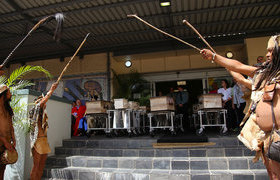‘Huiswaarts’: Sutherland Nine laid to rest in the ground of their ancestors
28 November 2023 | Story Helen Swingler. Photos Je’nine May. Read time 10 min.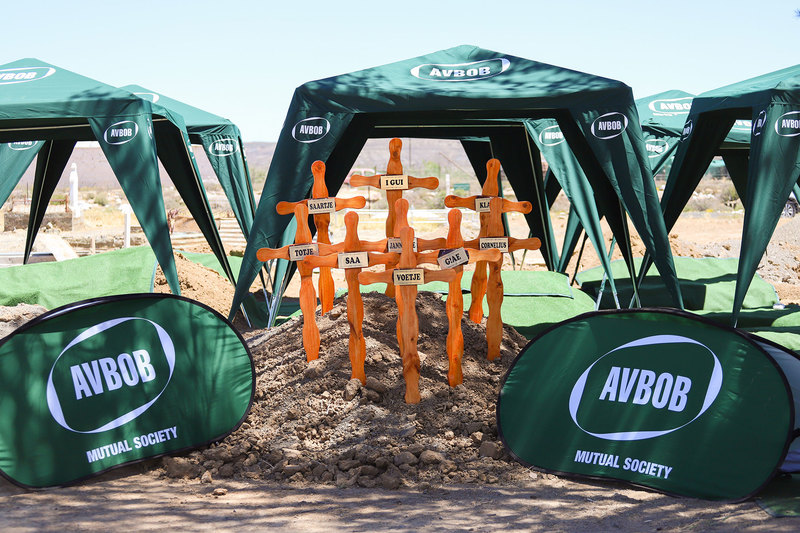
On a blisteringly hot Sunday on 26 November, the sacred remains of the Sutherland Nine were finally laid to rest in the Roggeveld Karoo, back in the land of their San and Khoi ancestors in the Northern Cape.
Eight of the six San and three Khoi people had been unethically removed from their graves on the nearby Kruisrivier farm nearly 100 years ago and given to the University of Cape Town (UCT) between 1926 and 1931 by a UCT medical student Carel Gert Coetzee, who lived on the farm.
The remains included five men, two women, and two children, a boy and a girl. The ninth, whose older remains were dated to the pre-colonial period, was excavated during roadworks in the Northern Cape. He had been buried in the nearby mountains.
In 2017, these human remains were discovered during an audit conducted by Professor Victoria Gibbon, curator of the UCT Human Skeletal Repository. It was a role that led her to initiate the restitution process and community-driven science project to identify and return the remains to Sutherland.
That journey of restorative justice, interrupted by the COVID-19 pandemic, took five years. It included extensive collaboration and engagement with the Abraham and Stuurman families (from the Northern and Eastern Cape) who share surnames with some of the nine, members of the Sutherland community, and the relevant political and cultural stakeholders.
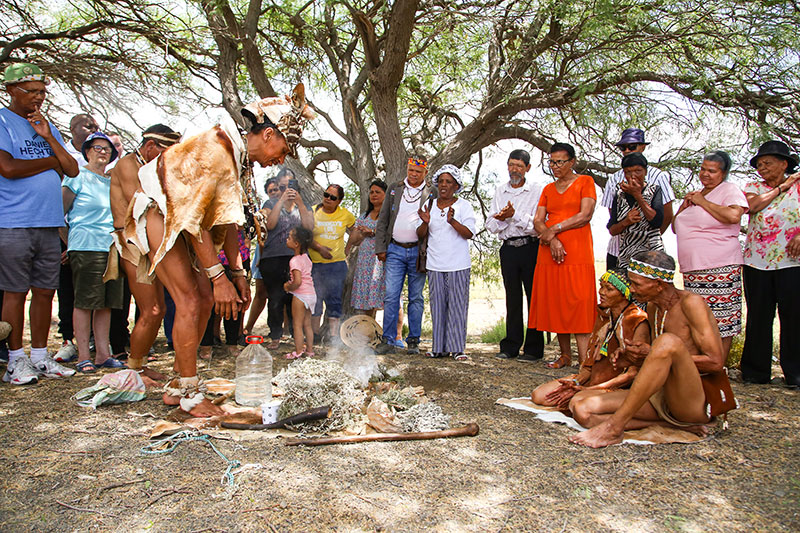
Blueprint for the future
The process yielded the country’s largest cross-institutional historical justice project, a blueprint for the future, said Professor Gibbon. The scientific studies established the gender and identity of the individuals, reconstructed their faces, provided insights into where and how they lived, what they ate, how they died and whether they were related.
The available records detail the first names of seven of the individuals and the surnames of two: Abraham and Stuurman, whose descendants still live in the area.
Integral to this was the work of public participation consultant hired by UCT, Doreen Februarie, who led the process with the Sutherland community.
Restitution and justice
The first day of the programme was hosted on UCT’s Faculty of Health Sciences, “a day of mourning”, said dean, Associate Professor Lionel Green-Thompson. On the second day, 25 November, the cortège that had departed from UCT arrived in Sutherland. And on the third day, Sunday, 26 November, a church service was held before the reburial in the town’s historic Anglo–Boer cemetery, where the community will have easier access to the graves.
On Saturday, the procession carrying the coffins made its way off the N1 at Matjiesfontein and along the R354 for the final 110 km, through the hard, sunbaked Roggeveld where the Sutherland Nine’s ancestors hunted, and to the edge of the Western and Northern Cape provinces.
At the provincial border, the cortège halted. Here, under acacia trees, there was a symbolic handover of the sacred human remains from one province to the other.
Smoke from burning impepho rose into the trees as the Western Cape San and Khoi representatives, chiefs Bradley van Sitters and Autshumao Mackie, exchanged greetings and performed a cleansing ceremony with their Northern Cape counterparts, Oupa Isak Kruiper and Atta Lydia Kruiper. Afterwards a horn sounded across the veld, ancient and evocative.
Return
Once the cortège reached Sutherland, the four leaders led the procession slowly down the main road to the bus stop where they were received by a jubilant Sutherland community.
The bus stop is symbolic of the community’s struggles as it once divided the town along racial lines, said Karoo Hoogland mayor, Anthony Stuurman Mietas. And it was here that the community could finally welcome their ancestors back, said Stuurman Mietas, who addressed the gathering.
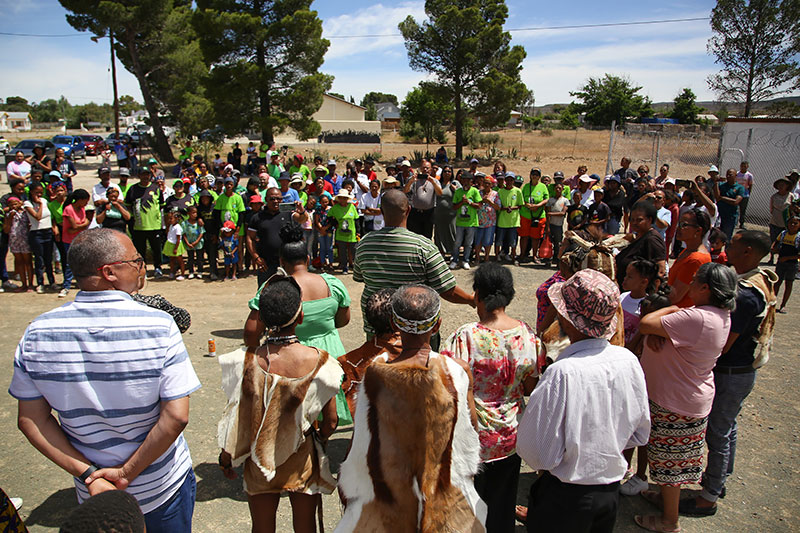
“It’s very profound and you have to realise the significance of this,” he said in an interview with UCT’s videography team. “Because of what just happened, we are now able to teach our children; tell them about the system and what it means to be a community.”
“So what this really means [is] that it’s almost like a validation of our existence.”
He said that the customs of their ancestors had gradually been forgotten, as had their ancestry and roots. “So, what this really means [is]that it’s almost like a validation of our existence. It’s a realisation of what people have been telling us all along. And now we have the remains of our ancestors, validating the stories of our elders.”
Rejoicing
The third day was a time for thanksgiving, a rousing ceremony at the Sutherland Verenigende Gereformeerde Kerk (VGK). The programme was hosted by local and district mayors of the Karoo Hoogland, government, community and family representatives, UCT representatives and the Reverend Stephen Pedro. Masters of ceremony were the mayor and Associate Professor Green-Thompson.
Speaking in Afrikaans, Green-Thompson said. “Friday was a day of mourning for UCT. It was a day of recognition, that we were part of violence committed against this community.” Offering UCT’s apologies once again, he added. “We have vowed never again.”
“Today is the third day [of the programme] and in the Christian faith the third day is the most important [as it is today] because we have returned to their original home of the people; we have brought them with us. They are back in the home of their forefathers and in this moment, we want to name their names.
“l gui, a 30- to 50-year-old man who lived between 1300 and 1400, found further away during road excavations. Those from Kruisrivier Farm were G!ae, a four- to six-year-old boy who lived between 1860 and 1870; Saa, a six- to eight-year-old girl who lived between 1860 and 1870; Cornelius, a 30- to 45-year-old man who lived between 1833 and 1878; Jannetjie, a 45- to 60-year-old woman who lived between 1835 and 1895; Klaas, a 40- to 60-year-old man who lived between 1820 and 1880; Saartje, a 30- to 45-year-old woman who lived between 1840 and 1880; Totje, a 25- to 30-year-old man who lived between 1858 and 1888; and Voetje, a man older than 44 who lived between 1865 and 1913.”
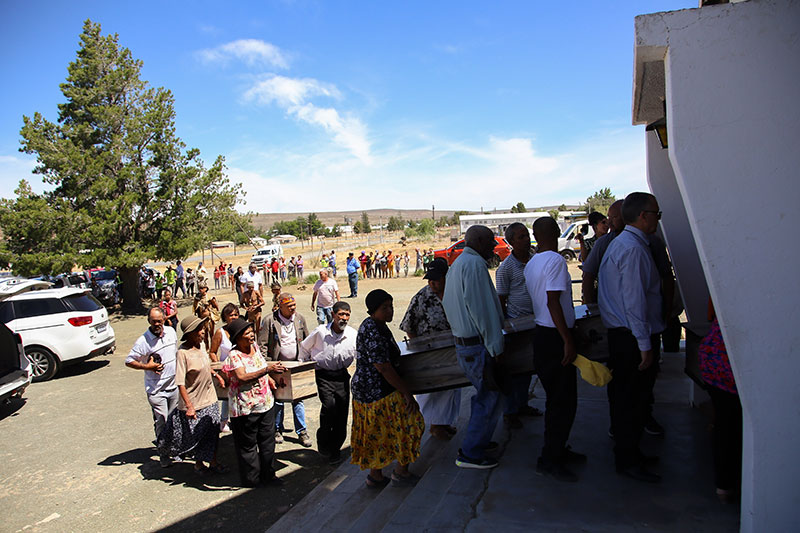
He added, “As I look at the faces of the children [in the gallery above], I can’t believe it; I see the faces of Saa and G!ae. And when we arrived at the Bus Stop yesterday, I thought, here they are again. In this moment we reflect that they [the Sutherland Nine] are home again and will be in their final resting place at the end of the day.”
In her address, Deputy Vice-Chancellor for Transformation, Student Affairs and Social Responsiveness Professor Elelwani Ramugondo acknowledged the work done by her predecessor, Professor Loretta Feris.
She said, “At the start, it was very clear that this journey would be led by the family [and] the scientists involved. The purpose was not only to return the remains to their rightful home but to understand the heritage of these members of the Khoi and San communities that first lived in this part of the country. The traditional leaders and families helped to give us direction.
“During the public participation process, the descendant families asked UCT to compile as much information as possible about their descendants … The families asked us to get as much information as possible, further than the 1920 records, to establish the lives they had led.”
She acknowledged the hard lives the deceased had lived.
“The scientific evidence showed a hardworking people who faced difficult circumstances but who persevered and lived.”
“The difficulties of the Khoi and San people in Sutherland in the later 19th century was made even harder by the violence and domination of colonialist settlers,” Professor Ramugondo said.
The subjugated San and Khoi, some children, were used as indentured labour on the farms. The remains found on the Kruisrivier Farm were evidence of this history and injustice, Ramugondo said.
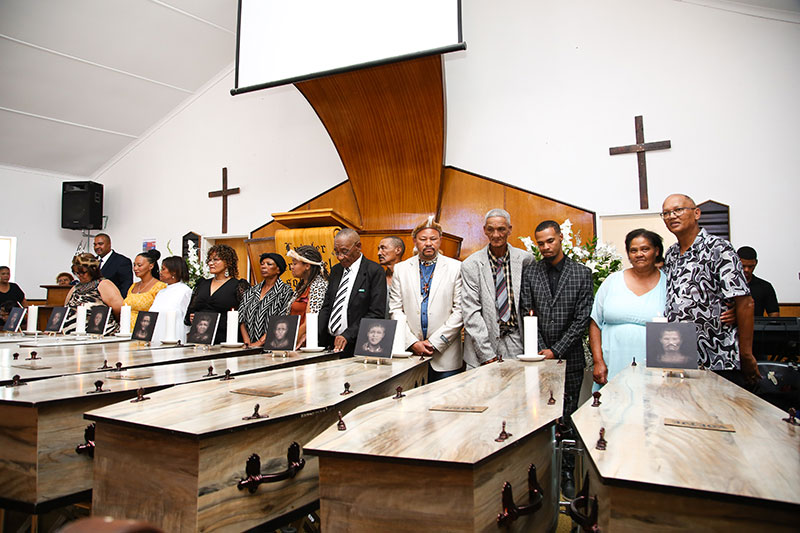
“The scientific evidence showed a hardworking people who faced difficult circumstances but who persevered and lived. Despite the challenges of their demanding existence, they showed their staying power and resilience – and they held fast to their cultural heritage.”
Part of the ceremony included a reading of her poem “Huiswaarts” [“Homebound”] by community member Beauty, a composition of injustice, longing, sadness and joy, capturing the story of the Sutherland Nine.
Reburial
After the closing, the Abraham and Stuurman families moved to the historical cemetery where a last cleansing ceremony was performed, and the burials accompanied by song and poetry – and closure as the soil was piled on top of the coffins, protected by metal sheets. Simple memorial wooden crosses bearing the names of the Sutherland Nine serve as their headstones, sunk into the burial mounds.
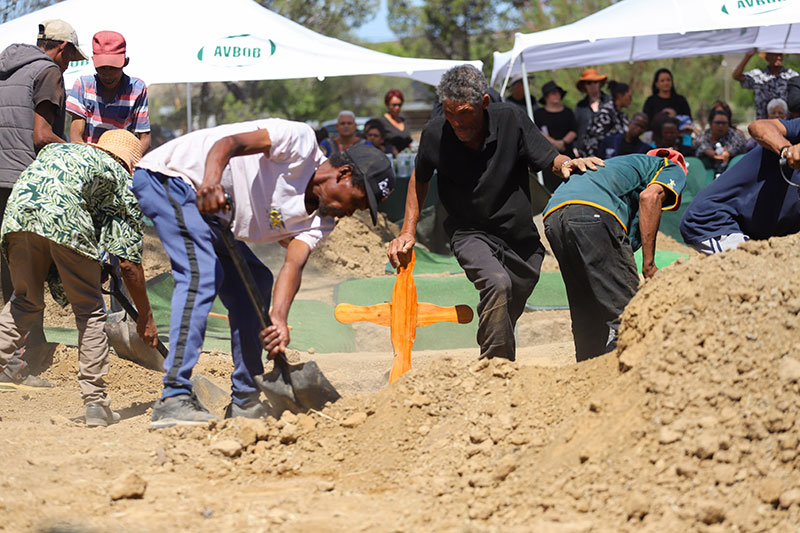
In a communiqué to the UCT community on 17 November, Vice-Chancellor interim Emeritus Professor Daya Reddy wrote that in co-hosting the historic event, it was imperative “to ensure that the Sutherland Nine’s sacred remains are reburied with dignity, but also to have UCT atoning for the bleak chapter in our history in a process that will include other restorative justice interventions to be co-created with the family and the community of Sutherland”.
 This work is licensed under a Creative Commons Attribution-NoDerivatives 4.0 International License.
This work is licensed under a Creative Commons Attribution-NoDerivatives 4.0 International License.
Please view the republishing articles page for more information.







